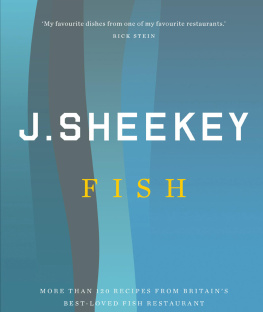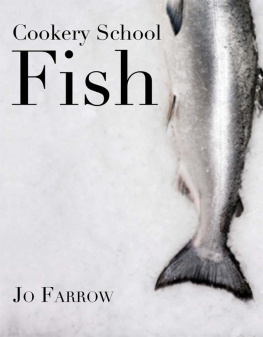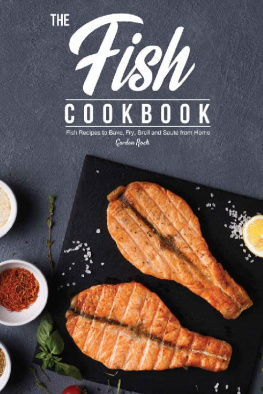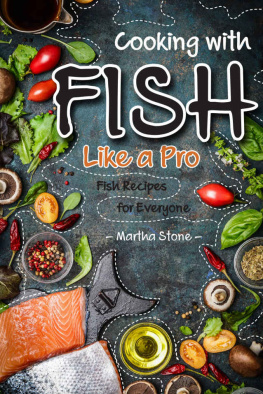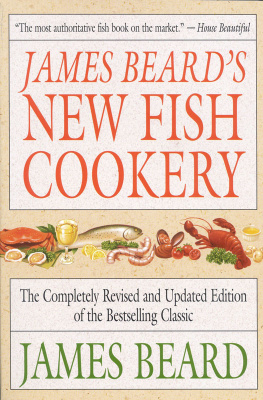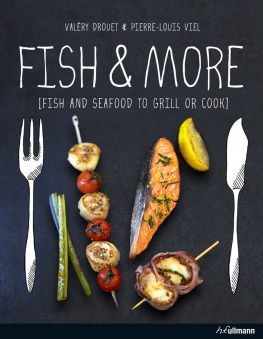CONTENTS
C ENTRAL L ONDON, WINTER MORNING , 7 AM STILL DARK .
Theatrelands lights are dimmed, actors and audiences left hours ago, the only people moving are an occasional policeman and the J Sheekey chefs waiting for deliveries from the many corners of Britains coastline.
First, wooden crates of native oysters that have been arriving at our door for more than a century. Gathered on the Essex coast since even before the Roman garrisons, todays are packed 100 to a box, cup-side down and covered with cooling seaweed. We will sell 300 to 400 today in half dozens and dozens, delicately poached in watercress soup or as the centrepiece to fruits de mer.
Next to arrive, shellfish harvested in the icy waters off the Isle of Mull: langoustines caught in creels unchanged for centuries. Scallops hand-gathered only the day before off the sea bed, to be served simply roasted in the shell. More deliveries come quickly: a box of beautiful turbot, the king of fish, and our signature Dover sole to be cooked whole on the bone and filleted with spoons, just as J Sheekey cooks have done for more than 100 years. Cornish cod arrives next, smelling sweetly of the sea, jewel-like musky red mullet, tentacled squid fished from Channel waters. Downstairs, chefs are skinning, pin-boning, trimming fins, portioning fish, making stocks, stacking the fridges with freshly caught slip soles, pollack, photogenic John Dory, each cook moving almost invisibly, fluidly in the narrow spaces.
Outside, there are many more people now, in buses, cars; commuters are walking up Charing Cross Road on their way to work. Some will pop in later for a fish pie for lunch. Others will come for a cocktail before seeing a play at one of the many theatres that surround this area of the West End. There will be couples, families, friends coming to celebrate a birthday or anniversary. Others just seeking a great fish supper. Post-theatre, there will be late workers, actors and their audiences, looking to unwind from the nights performance in an understated ambience of impeccable service.
Then, just a few hours later, after the restaurant is cleared and cleaned and the cooks have taken the night bus home, more crates of oysters will arrive, more chefs, more fish, for another day and another showing of the longest running theatreland performance in London.
R OBERT A RTHUR T ALBOT G ASCOYNE -C ECIL , 3rd Marquess of Salisbury, is best remembered by historians for the Boer War, the Anglo-Japanese Treaty and for three terms as Prime Minister of Britain during the late Victorian era. But food lovers have another reason to remember and thank him: for his patronage of Josef Sheekey, a fish and oyster trader in Shepherds Market, Mayfair.
It was while serving his last term in office, in 1896, that Salisbury granted Josef premises in St Martins Court to serve poached and steamed fish, seafood and shellfish, with the proviso he also supply meals to the Prime Ministers famous after-theatre dinner parties. The restaurant soon became popular with leading theatrical personalities, agents and promoters of the day, while still attracting the traders of Covent Garden Market.
Its glorious heyday came during the 1950s and 60s under the ownership of Josefs formidable granddaughter, the legendary Mrs Williams, whose portrait is still on our walls. Under subsequent ownership it slowly declined, until in 1998, it was bought by Chris Corbin and Jeremy King, who had an ambition to add a classic British fish and seafood restaurant to their Le Caprice and Ivy stable.
Corbin and King retained renowned designer David Collins with a brief to create a new restaurant that evoked the best of the old. The signature portraits of theatrical luminaries who had patronised the restaurant were lovingly re-framed and hung with an obsessive eye for detail that caused many of Kings friends to despair.
Period paintings were chosen with the help of surrealist expert and jazz singer George Melly and art historian Richard Shone. The menu remained faithful to the spirit of the original, too, although the 3rd Marquesss stipulation against fried fish was relaxed a little to allow room for our famous fish and chips.
J Sheekey quietly re-opened its doors on Friday, 6 November 1998 to acclaim from critics and old customers. Theatrical regulars returned, including Cate Blanchett, Helen Mirren and Alan Rickman, who favoured Champagne with chips. Londons best-loved fish and seafood restaurant had effortlessly returned to its glamorous glory.
In 2005 the restaurant passed into the sure hands of Richard Caring, who added our sister fish restaurant Scotts in Mayfair. And, finally, when the space next door to J Sheekey became available, the art deco Oyster Bar was born, with a new series of contemporary theatrical portraits commissioned. With its concentration on serving classic seafood and shellfish, perhaps half a dozen natives with Champagne, we like to think that, after 116 years, the old Marquess and Josef Sheekey would approve.
FISH CHART
WHEN FISH IS THE HERO
C OOKING FISH IS ABOUT CONFIDENCE , a good non-stick pan and an efficient hot grill. There is no need to be nervous. The first and most important thing is to find a good supplier. Track down a fishmonger you can trust travel if you have to because at the moment they are more under threat than some fish. Support them, make friends with them. If you have a good relationship with your fishmonger, he or she will be happy to supply you with fresh produce. They will save you bones for stock, put prime fish by when they know you are coming in, and order you in something special.
Fish is all about the moment.
Tim Hughes, Chef Director, J Sheekey.
Next, try to follow the seasons. Eat each fish when it is at its best: mackerel, salmon or sea trout in the summer; cod and pollack in the winter, maybe sprats when they smell sweet like cucumber. If you can, avoid flatfish such as plaice and Dover sole in the first few months of the year when producing roe eats up their energy and makes their flesh pappy. Leave them to spawn; a female cod for instance will lay more than 4 million eggs, of which only a handful will become adult fish and the rest will be food for other sea species. Again, ask the advice of your fishmonger, they will be well versed on the seasonality and availability of fish; though this book will guide you too.
Next page
